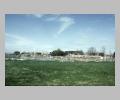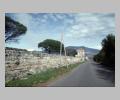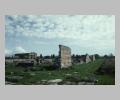| Summary: | Also known as Paestum; a maritime city established by Greek colonists near the Heraion at Foce del Sele. |
| Type: | Fortified city |
| Region: | Lucania |
Periods:
Archaic
Classical
Hellenistic
Roman
Physical:
Paestum was established on the coast at the edge of the Sele plain, ca. 10 km S of the Heraion at Foce del Sele. The site was well chosen for its agricultural potential and the possibility for maritime trade.
The city was enclosed in ca. 5 km of fortification walls and laid out on a grid system. In its design, the central zone of the city was reserved for religious and public buildings. From a central agora, or forum, the major north-south street, the paved Via Sacra, led N to the temenos of Athena, which also included the temple of Ceres. The street continued on to the N city gate. The Via Sacra ran S from the agora to the city's sanctuary of Hera, which included the major temples dedicated to Poseidon and Hera, and a number of smaller temples, treasuries, and altars. The paved street continued from the S religious precinct to the S city gate. In the area of the agora were located additional religious buildings and the major public buildings, including the bouleutron, curia, gymnasium, baths, and the ampitheater. The residental and commercial quarters extended E and W of the central public zone of the city.
Description:
Poseidonia was established and fortified by Greek colonists from the city of Sybaris, farther S, in the 7th century B.C. At ca. 400 B.C. the city was conquered by the Lucanians who renamed it Paiston or Paistos. In 273 B.C. Rome established a colony at the city and latinized the name to Paestum. During the Roman period the prosperity of the city began to decline due to the silting of the Sele river which turned the area swampy and caused it to become infested with malaria. By the early Christian period the city was reduced to the size of a small village and in the 9th century A.D. it was finally abandoned. The location of the site was forgotten and not rediscovered until a road was constructed through the swamp in the middle of the 18th century.
Sources Used:
Other Bibliography:





